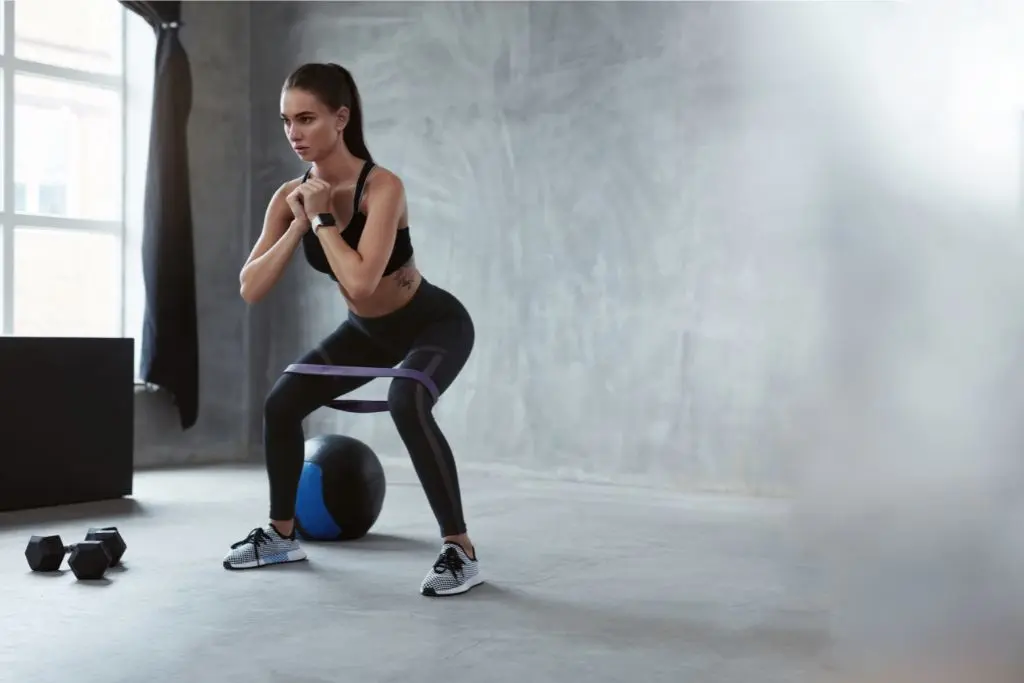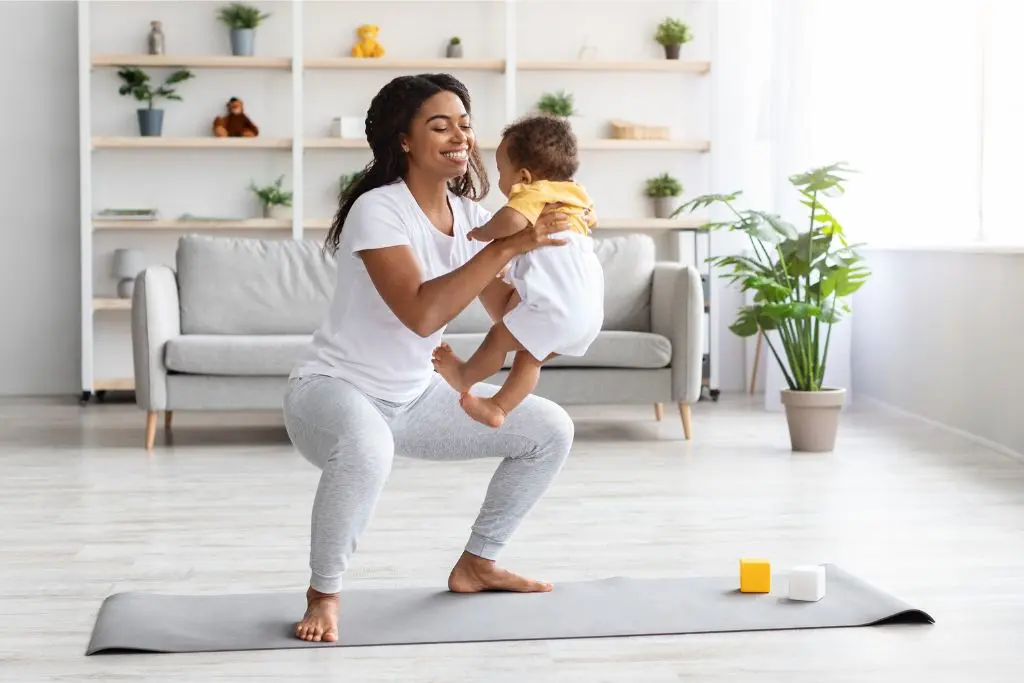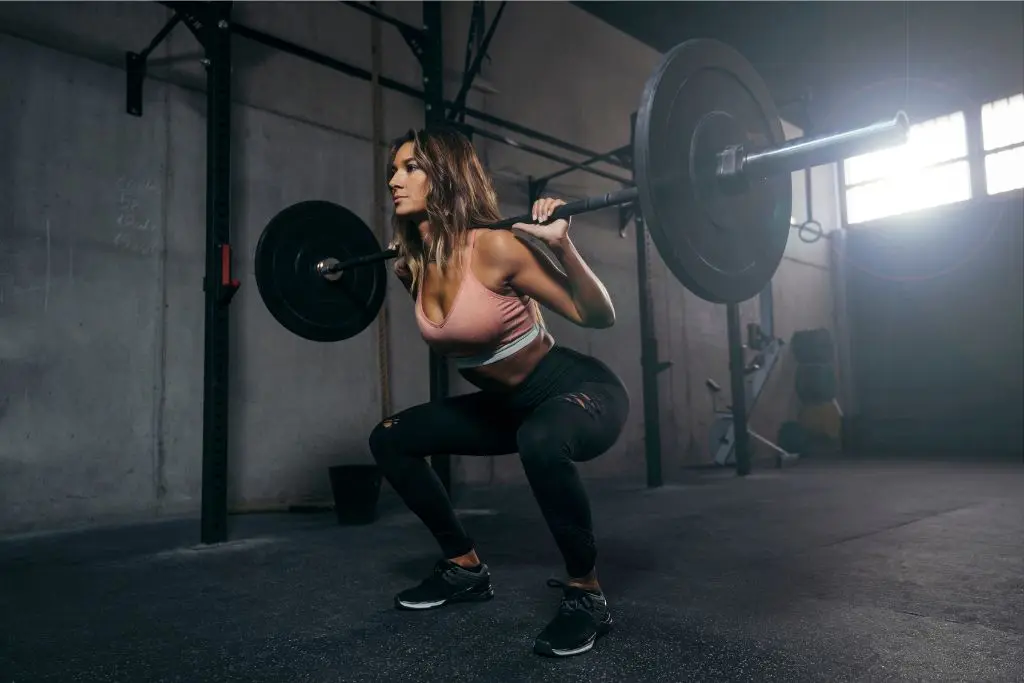9 Squat Mistakes You Want To Avoid
It's time to master your squat form and level up your journey

October 11, 2023 - Updated August 13, 2024

Squats are a fundamental compound exercise that feature heavily in a number of Sweat programs, regardless of the training style. Whether you’re doing strength training, practising yoga or Pilates or following a HIIT program, squats are an amazing way to build your lower body and core strength, make progress with weight training, and work some of the major muscle groups in your body all at once.
As much as we love this versatile movement it’s super easy to pick up bad habits at any point in your fitness journey, which can have a detrimental impact on your safety, progression and the effectiveness of your training. Want to master proper squat form? Here are nine squat mistakes you want to avoid.
Your knees cave inwards
This is one of the most common squatting mistakes. Your knees can cave inwards during any part of a squat, but for most people this tends to happen when you’re pushing up out of the squat back to standing position. This puts your knees and the surrounding ligaments under more stress as they take the brunt of your weight (plus any additional weight you’re squatting with!). Squatting doesn’t usually cause knee pain or injury, but asking too much of your knees definitely can.
The solution: Move with control and focus on sending your knees over your toes to prevent them from caving in. It can also help to loop a resistance band just above your knees, which will encourage your knees to push against the resistance and build correct muscle memory. Inward knee movement can come from a lack of mobility in your hips, so working on your mobility with hip stretches could support your squat form, too.

Your heels lift off the ground
Another no-no when it comes to proper squat form? When your heels get some airtime. What’s the big deal? When your heels lift, your weight moves forward, weakening and unbalancing the movement, changing the muscle engagement, and putting more stress on your knees. Pushing through your toes rather than the entire base of your foot can mean less power and increase your risk of toppling over.
The solution: At the base of each rep, focus on driving through your heels and entire foot. If you need to reduce your weights or limit your squat depth slightly until your heels are consistently staying on the floor, then do it! If you’re finding it really tough to keep your heels down, this could be due to tight ankles, in which case working on your ankle mobility would be a big help.
Your hips rise first
Once you’ve reached the lowest point of your squat and are about to rise back up to your starting position, your hips and torso should rise together in unison. However, for some people, their hips push back and up before their torso rises. This might feel like you’re putting more emphasis on your glutes and lower body, but it’s bad squat form and puts pressure on your hamstrings and back, while taking the load away from your quads.
Letting your hips and bottom lead the upward motion can mean the exercise is working the wrong muscles and increase your risk of injury - especially if you’ve got a barbell on your back.
The solution: Focus on engaging your core by drawing your belly button towards your spine, and instead of thinking about pushing your butt backwards to rise out of the squat, focus on pushing your hips forward. If your main issue preventing your hips and torso from rising in unison is a lack of strength in your quads, incorporate more quad-dominant exercises (such as lunges and split squats) in your workout routine to strengthen that muscle group.

Rounding your upper back and shoulders
When people get nervous about the risk of injury when it comes to squatting, it’s generally related to back concerns. The best way to keep your squats strong and safe is to avoid letting your shoulders and upper back round.
The rounding of your shoulders can lead to pain or injury in your back or neck, and also means you’re missing out on some of the biggest benefits of your squat. When your upper back rounds, your core tends to be less engaged, which means you’ve lost a huge source of power for each rep and are missing out on the core-strengthening benefits, too.
The solution: Focus on keeping your spine straight and your chest proud with shoulders back. You don’t want your shoulders and spine to be arched like a banana, just maintain a strong neutral position throughout. If you’re lifting additional weight such as dumbbells or a barbell and find your shoulders rounding, lighten or drop the weights entirely until you can squat with correct form.
Rounding your lower back, aka butt wink
We’re not done with your back just yet! Keeping an eye on your lower back is just as important during your squats. A common squatting error is to let your lower back round at the base of your squat, so your glutes and pelvis tuck under your torso. In gym speak, this is referred to as ‘butt wink’.
Letting your pelvis tuck under like this can put a significant amount of strain on your lumbar spine and put you at greater risk of injury, particularly if your goal is to lift heavy weights.
The solution: Slow your reps down and focus on keeping your spine in a neutral position throughout. If you feel your pelvis starting to tuck under, try reducing your squat depth slightly and see if that makes a difference.
Butt wink can be caused by a lack of core strength, so incorporate plenty of core exercises in your routine and focus on pulling your belly button towards your spine during each rep. The other common area of weakness behind this issue is actually your hips, so continue to implement hip stretches and strengthening exercises to work on building muscle and mobility in that area.
You’re not squatting deep enough
While this one isn’t so much an injury risk, failing to squat deep enough means you’re limiting how much you could be getting out of your squats. And you want to get as much out of them as you possibly can! Partial squats work the same muscle groups, just far less than if you were achieving a full range of motion.
The solution: Aim to have your thighs parallel to the floor, even if you’re not quite there yet. If that level of depth feels challenging or unbalanced, you can use a box, bench or chair to practice lowering your body to different depths, lightly tapping your glutes down, then rising back up.

You’re not engaging your glutes
Believe it or not, you canactually perform a squat primarily using muscles that aren’t your glutes. A common error is to drive upwards using your quads, which means less benefit for your glutes, increased strain on your knees and hips, plus limiting your potential for lifting heavier weights. You need the power from your glutes for heavy lifting - they’re one of the biggest muscles in your body!
The solution: At the base of your squat, engage your glutes before you drive up by thinking about spreading the ground apart with your feet. As you rise to the top of the movement, squeeze your glutes.
You’re using a barbell pad for back squats
We know barbell pads seem like a nice comfy addition to a cold, metal bar, but don’t use a barbell pad for a back squat. They’re not neck pads - they’re there to protect your hips during hip thrusts. When you use a barbell pad during a back squat, the barbell is immediately in the wrong position and will affect your range of motion.
The solution: Ditch the barbell pad and get comfortable with the bar on its own. It’s safer and more effective. If the bar is hurting the bony part of your neck, it’s in the wrong place and is sitting too high. Move it down your back slightly.
You’re looking up or down
The position of your gaze can alter the position of your neck and change the alignment of your spine, impacting your balance, power, and even affecting your core muscles and pelvis. Don’t worry - you don’t need to watch your feet and you certainly don’t need to look at the ceiling, so keep your eyes ahead!
The solution: To keep your neck in line with your spine, focus your gaze on a spot ahead of you on the floor or wall to keep your head upright in a neutral position.
Squat with confidence and get the most out of every single rep by learning these common mistakes and making an effort to keep them out of your workouts. If you’re just starting out with your fitness journey or aren’t sure if your squatting technique needs some work, it can help to use a mirror, film yourself, or ask a staff member at your gym for guidance!

A more empowered you starts with Sweat, and our editorial team is here to bring you the latest fitness tips, trainer recommendations, wellbeing news, nutritional advice, nourishing recipes and free workouts.
* Disclaimer: This blog post is not intended to replace the advice of a medical professional. The above information should not be used to diagnose, treat, or prevent any disease or medical condition. Please consult your doctor before making any changes to your diet, sleep methods, daily activity, or fitness routine. Sweat assumes no responsibility for any personal injury or damage sustained by any recommendations, opinions, or advice given in this article.
Fitness